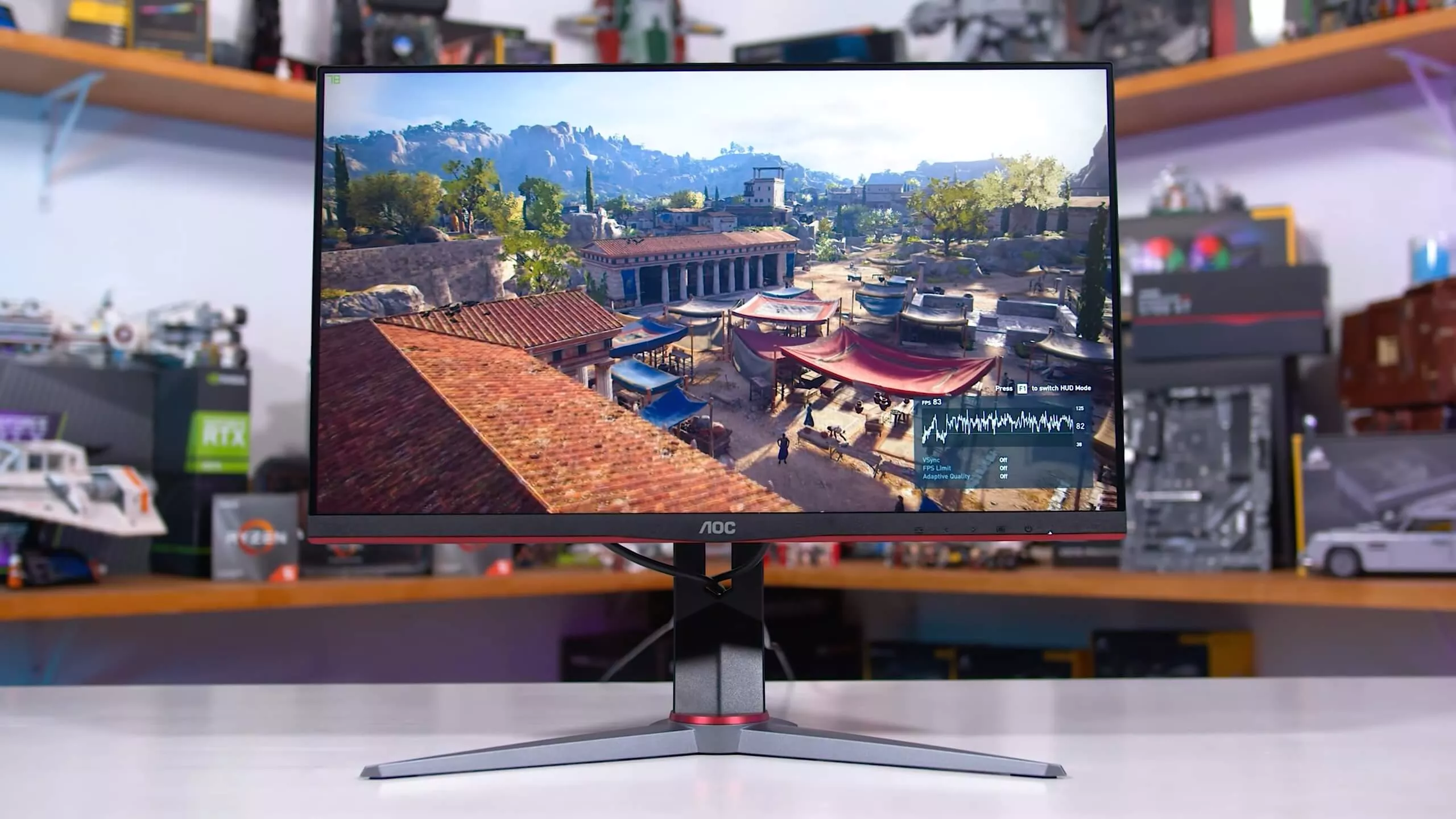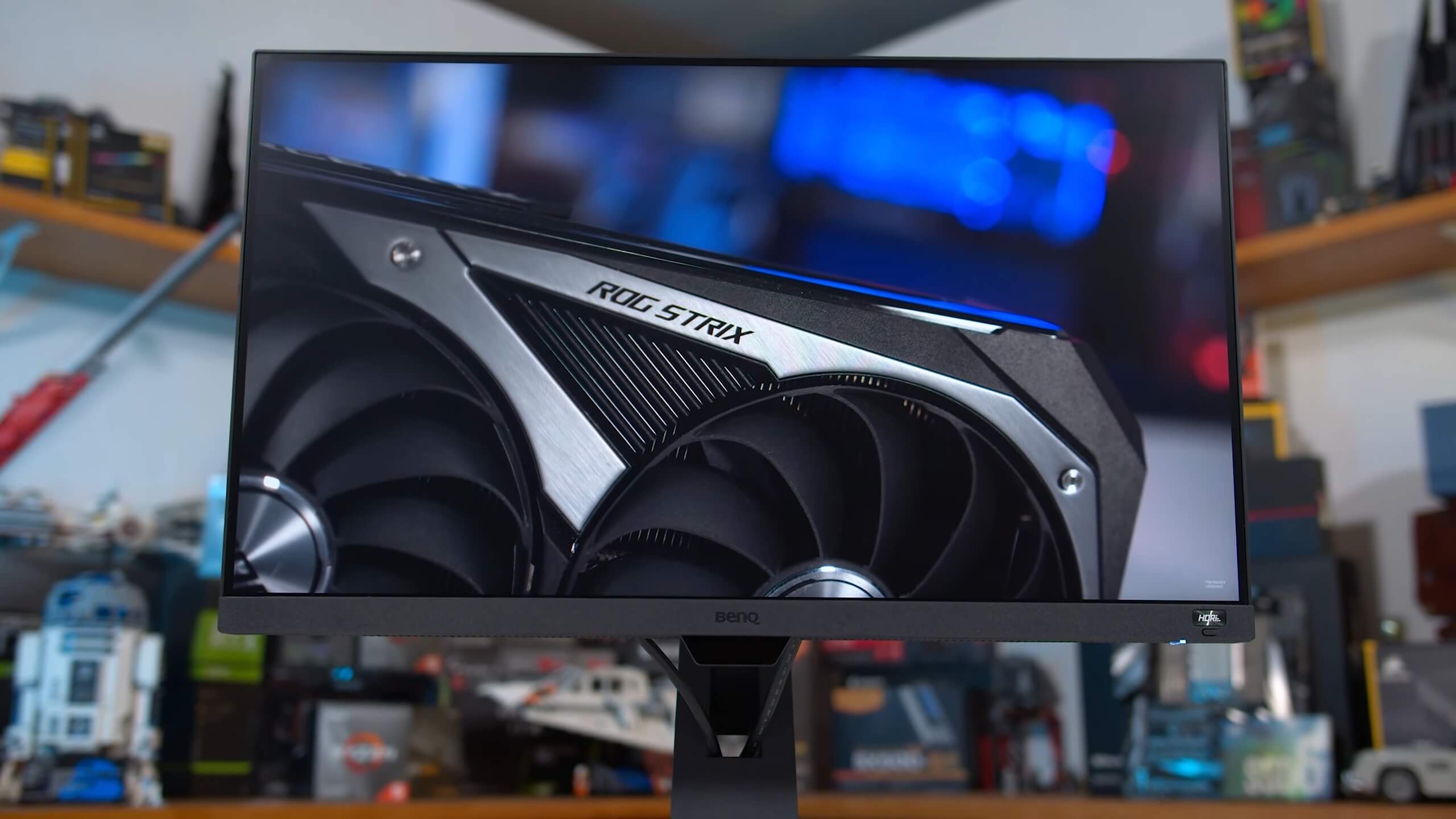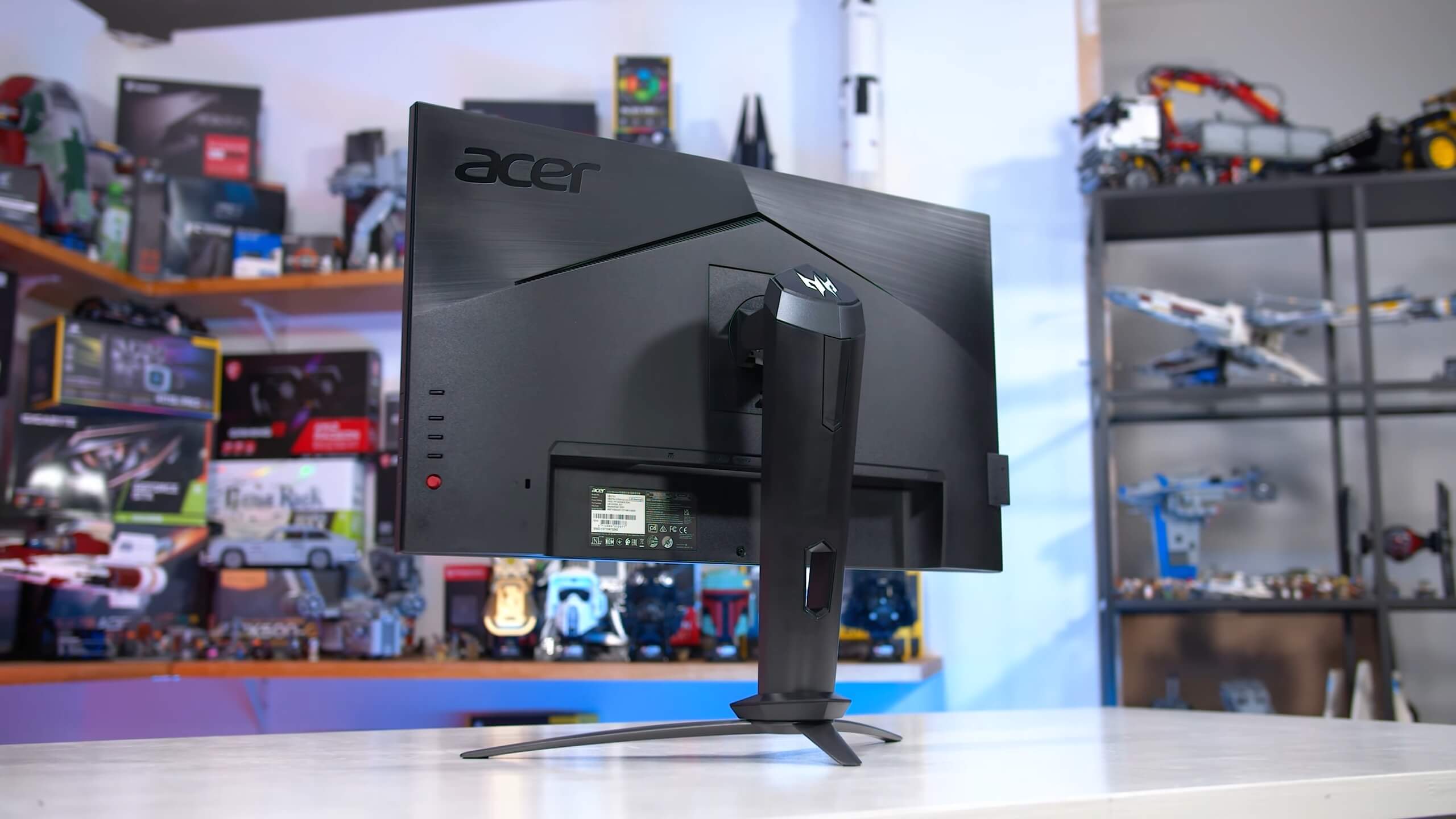Let's talk about monitor formats. Are you ready to step up into the world of 4K gaming, or is a more traditional 1440p or even 1080p display ideal for your setup? What about ultrawide displays, how do they fit into the picture? We're going to answer some of the major questions we often hear in this article for 2022.
Primarily, we'll be looking at the monitor options you can get on the market today, and how the pricing structures differ for each line. For example, generally how much more expensive is it to go with a 4K monitor over 1440p, and what sacrifices are you making along the way? What sort of GPU performance hurdles are there to upgrading or choosing a higher resolution? We test many monitors each year and somehow we've never really talked about this, so we'll give it a shot.
When to Buy a 1080p Monitor?
We'll start with a discussion on 1080p monitors because whenever we review a 1080p display we often see comments asking why you would buy a 1080p monitor in this day and age. And I think there are two primary reasons why you should still consider a 1080p display.
The first reason to go 1080p is simply that they are the most affordable monitors. If you don't have a lot of cash to spend, 1080p might be your only choice. As it stands today, some excellent 1080p monitors often go on sale below $200, like the AOC 24G2. So if you only have $200 to spend you can still end up with a decent 144Hz 1080p display that will be good for gaming. Meanwhile, the price floor for 1440p monitors is around $250 and at that price you're not getting the best that 1440p has to offer, whereas today's budget 1080p IPS panels are quite decent in how they look and perform.
For a lot of buyers, saving up the extra $50 to $100 to grab a higher resolution display is a tough ask, especially when that extra cash may be put towards a PC hardware upgrade like a faster GPU. And with the vast majority of today's mainstream GPUs being able to run games at 1080p high quality settings at decent frame rates, choosing a 1080p display ensures that your PC will be able to run games without issues or other sacrifices. Especially at a 24" size where the pixels don't feel too massive, I think that experience is very good for budget shoppers.
The other reason for buying 1080p is that you primarily play competitive esports games. The majority of competitive gamers and even the pro-level tournaments of today use 1080p monitors.
The other reason for buying 1080p is that you primarily play competitive esports games. The majority of competitive gamers and even the pro-level tournaments of today use 1080p monitors. 1080p monitors are available at higher refresh rates than any other display format, and the requirements of running games at this resolution are low, allowing for super high frame rates. The combination of a high refresh rate with a high frame rate substantially reduces latency compared to other configurations, which can give serious competitive gamers an edge.
For gamers starting out with more competitive play, 1080p 240Hz displays are pretty affordable these days. Options like the LG 27GN750 and Asus VG259QM are usually available below $300 and are a great entry point to high refresh gaming, while still providing great IPS image quality, not the crappy TN tech of old.
If you wanted that refresh rate but at a higher 1440p resolution, you're faced with spending at least double the price, which puts that sort of display out of reach of most mainstream or mid-range PC gamers. If I'm faced with the option of 1080p 240Hz or 1440p 144Hz at the same price – which is the case right now – the better, faster-paced competitive experience will be delivered by the 1080p display.
1080p also services high-end competitive gamers well with 360Hz options and several top-end TN options with excellent backlight strobing for the clearest image quality, such as the BenQ XL2546K. Those sorts of features are yet to make it across to 1440p displays, so 1080p is justified here if that's what you're after.
There are a few other minor considerations at play. 24-inch displays are typically only available with a 1080p resolution, so if you need something small for your desk, 1080p is a great choice. I also think buying something 1080p could be a decent option as a second display for budget or mid-range setups, even if your primary display is 1440p.
When to Buy a 1440p Monitor?
As we've said in many reviews over the last few years, 1440p is the sweet spot for gamers today. The main reason for this comes down to the pricing structure of today's monitors. Let's take a look at a typical medium refresh rate monitor, something around 144Hz and 27 inches in size. For a 1080p display you're looking at between $200 and $250. For a decent, but still budget-friendly 1440p display like the Gigabyte M27Q, pricing is between $300 and $350. Then to jump up to 4K 144Hz, and get a product like the Gigabyte M28U, which is $600 or more.
In other words, going from 1080p to 1440p costs you about 50% more for a display panel of similar quality, same sort of response times, same IPS technology, same great colors. But then going from 1440p to 4K doubles the price.
Many people (including myself) feel that the step up from 1080p to 1440p in games is visually more substantial than going from 1440p to 4K at these sorts of panel sizes, so being able to get that sort of upgrade at only a 50% increase to pricing is great bang for buck.

Normalizing for price, let's say you want to spend $350 on a monitor. Your options would be a 1080p 240Hz display like we talked about previously, a 1440p 170Hz-ish display, or a 4K 60Hz display. Unless you are really keen on competitive gaming, the 1440p 170Hz display is going to be the most balanced, delivering a decent resolution to keep games looking nice and crisp, while also delivering a decent refresh rate to ensure smooth gameplay.
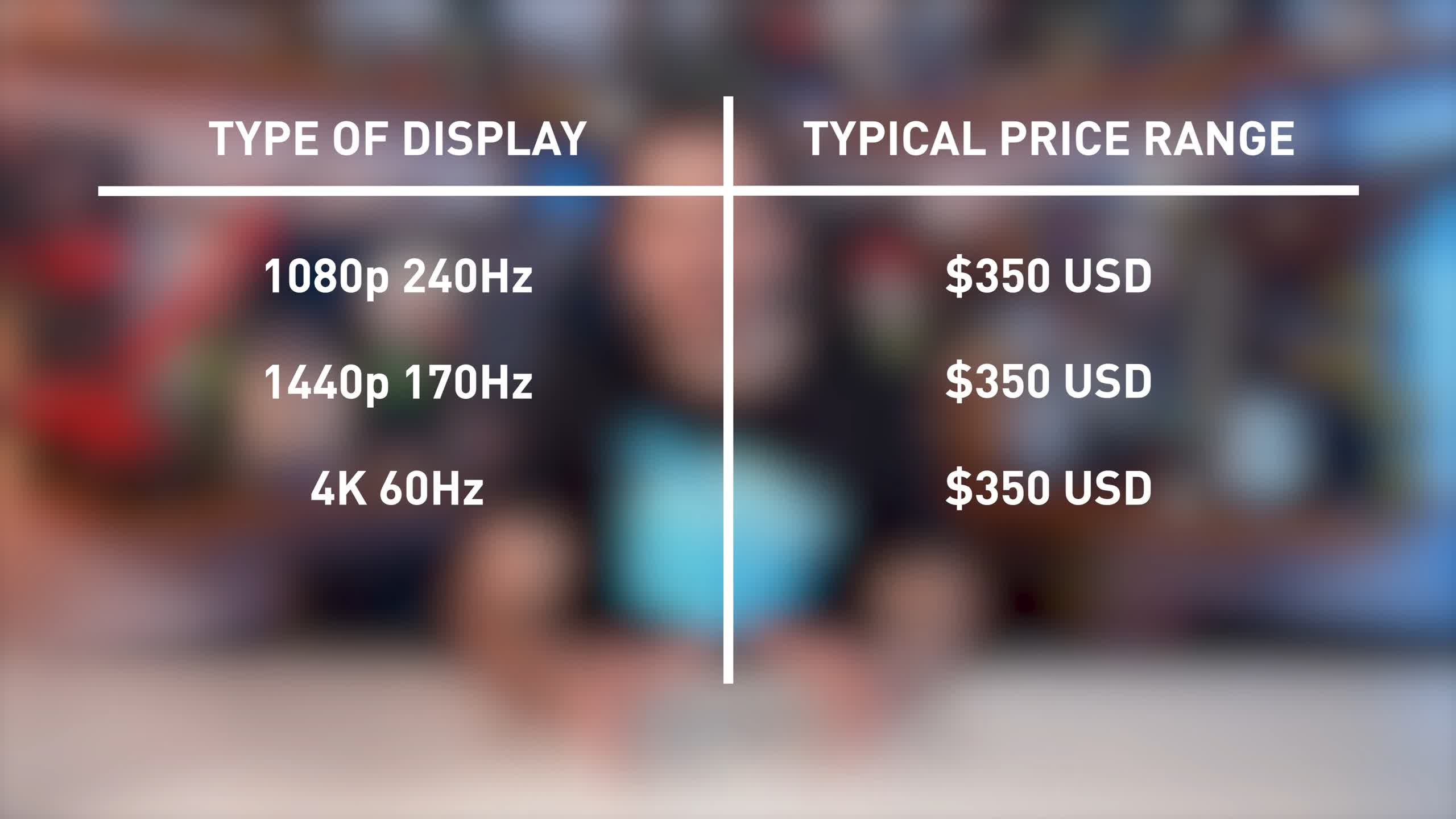
4K options at this price lack a good refresh rate for gaming, while 1080p monitors lack the resolution, especially if you're playing today's visually stunning AAA titles. 1440p sits nicely in the middle and offers something for everyone.
The equation even comes out nicely in favor of 1440p comparing pixel counts, 1440p monitors are roughly 50% more expensive for 78% more pixels, so if we make up a "cost per pixel" metric, it's looking pretty good there. But it's not just the "bang for buck" factor that makes 1440p a good choice.
There are simply a lot more 1440p monitors on the market right now than any other display type, so finding the exact monitor to suit your needs is easier. There are options at any price point between $250 right up to $900, depending on the display panel technology, refresh rate, size and quality that you want. This allows you to optimize for certain criteria, like wanting a VA monitor for its deep blacks, or needing a KVM switch, things that aren't as available with 1080p monitors (at least to the same quality level).
One thing that's often overlooked in the discussion between 1080p and 1440p is the quality of the panels themselves.
One thing that's often overlooked in the discussion between 1080p and 1440p is the quality of the panels themselves. While response time performance is generally pretty similar between the same panel technologies at different resolutions (like comparing 1080p IPS to 1440p IPS), 1440p monitors typically have the advantage in color gamuts. I'm yet to see a 1080p gaming display with 80% Rec. 2020 coverage, allowing for great performance in DCI-P3 and Adobe RGB color spaces. That sort of thing is readily available in the 1440p market, adding additional versatility to gaming displays that you might also want to use for content creation or consumption. However, elements like brightness, contrast ratios and viewing angles don't differ substantially, those are more down to individual monitors.
We've also found that 1440p displays are more usable across a wider range of panel sizes. At 32-inches for example, 1080p displays look low resolution and there's an aspect of being able to "see the pixels." That's not the case with 1440p, and again there are a wider range of better quality 32-inch panels here than in other resolution classes. That cements 1440p as the versatile choice in 2022 with an option for any type of gamer.
We've also seen the emergence of high refresh rate 1440p displays, delivering up to 240Hz or even 270Hz refresh rates for competitive gamers. While these are much more expensive, they do again offer excellent versatility, and are what I'd choose if you want to dabble in both competitive and AAA gaming.
The resolution gives you a crisp experience when playing games like Guardians of the Galaxy and Cyberpunk 2077 at lower frame rates, but then if you want to jump into Fortnite or Rocket League, the high refresh rate gives you a smoother, lower-latency experience.

I see these 1440p 240Hz displays as very future-proof, perhaps the most future-proof of any display type available today as they have the resolution and refresh rate to last 5+ years without needing an upgrade. Whereas with 1080p 240Hz or even 4K 144Hz you might think about an upgrade sooner to access either higher resolutions or higher refresh rates. 1440p is the only format that offers a bit of both.
If you think 1440p is right for you, the main consideration to make is the performance of your PC.
If you think 1440p is right for you, the main consideration to make is the performance of your PC. Across our latest 12 game samples with modern titles, moving from 1080p to 1440p is going to result in a 25 to 35 percent performance drop, depending on the GPU you have. It will also increase VRAM utilization, putting more pressure on 4GB and 6GB cards in particular.

So for a GPU like the RTX 2070, if you were previously getting 110 FPS at 1080p, you can expect around 80 FPS at 1440p as a rough guide. Similar with higher performance cards like the RX 6700 XT, which drops from ~160 FPS down to 115 FPS. This should only be an issue with mid-range cards or lower, as most GPUs including the RTX 2060 are still capable of gaming at 1440p even with high or ultra quality settings.
On the other hand, 1440p isn't an ideal resolution for console gaming. While the Xbox Series X does support 1440p outputs and gaming at that resolution, the PlayStation 5 and older Sony consoles do not. There are some 1440p monitors that will accept and downscale a 4K input, but often this is limited to just 60Hz, and the quality can be hit or miss depending on the monitor. This is something to keep in mind if you want to do both PC and console gaming.
When to Buy a 4K Monitor?
With the slate of releases in this category in the last year or so, I do think it's now worth buying a 4K gaming monitor in some instances. These days, high quality 4K high refresh monitors are available for $650, which is quite reasonable.
4K gaming is for high-end buyers. If you're on a budget, if you're wanting the best bang for buck, or if you just have mid-range gaming hardware, 4K is not the format for you. It does offer a better visual experience than 1440p, but there are diminishing returns, especially at the high prices of 4K monitors today compared to 1440p. Typically you're looking at spending at least double on a 4K monitor vs 1440p for similar specifications.
But if you want the highest available resolution for gaming at a respectable refresh rate, 4K is for you. It's also worth it if you have a high-end gaming GPU. While an RTX 3080 Ti or RX 6900 XT are typically good for over 150 FPS at 1440p, they're still able to hit 100 FPS or above in many of today's games at 4K, and over 60 FPS in the most demanding games like Cyberpunk 2077 and Assassin's Creed Valhalla. If you have a preference for visual quality over pure FPS performance and you're playing a lot of single-player titles with a powerful GPU, there are definitely some benefits to going 4K - and a lot of the time the experience will still be very smooth.
Of course, there's a performance cost, and it's higher than going from 1080p to 1440p. Moving from 1440p to 4K typically sees a 40 to 45 percent reduction in performance, and cards with less than 8GB of VRAM will struggle at times. Compared to 1080p, 4K sees a 60% performance drop or greater. The impact of this can be mitigated to some extent with technologies like DLSS and FSR, but there's no doubt upgrading to 4K has the highest performance cost and a lower visual improvement than other resolutions. This is why we recommend 4K displays only for high-end gamers with GPUs like an RTX 3070 or better.
An additional benefit about buying a 4K monitor is their level of versatility. 4K monitors are generally excellent for productivity work, text is extremely sharp, there's lots of screen real estate for your applications, and most 4K monitors have great wide gamut support for creative workloads. It's also the perfect resolution for today's content consumption, as a lot of TV shows and films are released at 4K. If you're doing a lot of things at your PC aside from gaming, 4K displays are a significant upgrade and worth the price premium – but make less sense as pure gaming options.
32-inch displays and above benefit the most from the additional resolution, and these benefits only get larger as the screen size increases. A 42-inch 1440p monitor won't look great, but 4K is very usable at that size or even larger. Unfortunately though, 32-inch 4K gaming monitors are one of the most expensive categories you can find today, and some larger format displays aren't the best quality.
4K monitors are also the perfect choice for console gaming. Both the Xbox Series X and PlayStation 5 can output up to 4K 120Hz, and to get the full benefit of this you'll need a 4K gaming display. These sorts of monitors are the best for pure console gaming with no PCs attached, the best for people playing on both PC and console, and the best for future proofing in case you want to add more devices in the future. Just make sure you get a display with proper, full HDMI 2.1, which is not every 4K high refresh display on the market.
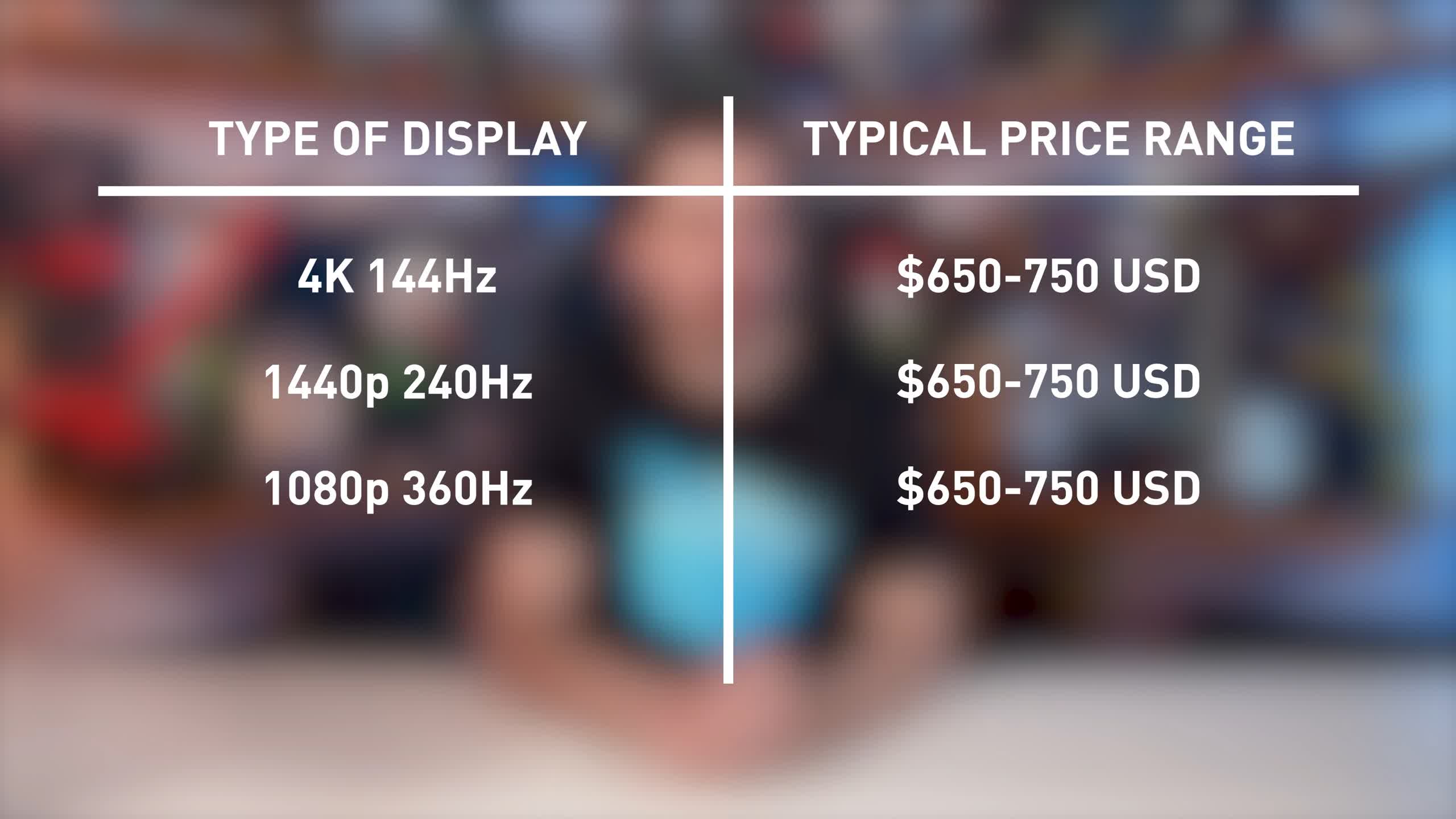
In terms of similarities to other resolutions, 4K displays are generally just as fast and have just as good color performance as 1440p monitors, if not better, but this does depend on the exact monitor. Today's 32-inch 4K displays, for example, are not as fast as a similar refresh rate 1440p offering, so that's something to keep in mind. Features like backlight strobing may also be less refined than on lower resolution monitors.
The other important question is what alternatives are on the market at a similar price to 4K monitors? If we take $650 to $750 as the entry point for decent 4K 144Hz monitors, at a similar price you can also purchase 1440p 240Hz displays. 1440p 240Hz provides the additional versatility of a high refresh rate for competitive gaming, while 4K is superior for productivity and console use. So you'll have to toss up what matters most to you. Both options should be very future proof and provide years of usage, just optimized for different use cases.
When to Buy an Ultrawide Monitor?
Like 1440p displays, ultrawides are available in a huge number of different variants, going from as little as $350-400 at the low end, to over $1,000 for premium flagships. It's also just a very different format, and not everyone will appreciate the extra width. I personally find it more immersive for gaming and I do appreciate the width for productivity tasks, but that's a personal preference more than a matter if it's better or worse than a traditional 16:9 display.
But let's say that you are interested in an ultrawide monitor. What to get then?
There are decent options in the $400 to $500 range, however there is a noticeable price premium over 16:9 1440p monitors. If you want a curved VA with a 3440 x 1440 resolution, you're looking at spending at least $400, compared to $250 for the same specs at 1440p. An IPS alternative will set you back roughly $500, compared to $300 for a 16:9 configuration. And this is typical for all ultrawides, with pricing around 60% higher than a similar 16:9 display for the additional width.
Ultrawides generally allow for split-screen use, with two apps running side by side, similar to a multi-monitor setup. With 21:9 you don't get as much real estate as two 16:9 monitors, but pricing is also cheaper for a 21:9 monitor, and that may be a better choice for a single-display setup.
There are some limitations to be aware of though. Aside from super premium and unusual monitors like the Samsung Odyssey G9, most ultrawide monitors don't have as high-end specs as you can get from a 16:9 monitor. For example, there are lots of 1440p 240Hz displays right now, but none that hit that refresh rate at 3440 x 1440. Similar with 4K-class ultrawides, we're just starting to see great 144Hz options for regular 4K displays, but that sort of refresh rate hasn't come to 5120 x 2160 monitors in a serious way yet.
Because most reviewers don't test every ultrawide resolution, a good rough guide to go on is that 3440 x 1440 sits right in the middle of 1440p and 4K performance and 2560 x 1080 sits between 1080p and 1440p.
As for performance considerations, ultrawide formats require more horsepower than their 16:9 counterparts. Because most reviewers don't test every ultrawide resolution, a good rough guide to go on is that 3440 x 1440 sits right in the middle of 1440p and 4K performance and 2560 x 1080 sits between 1080p and 1440p. So if you are thinking of upgrading to an ultrawide, expect to see a ~20-30% reduction in performance compared to the non-ultrawide resolution.
---
Luckily, these days there are so many monitor options (see some solid buying recommendations below) that there should be something for everyone. It's also important to note just how many formats may be available at the price point you are considering. There may be more options available to you than you realize within your budget, especially around the $400 to $700 mark. You may be able to get a higher resolution or higher refresh rate than you were expecting, which may have benefits.
Shopping Shortcuts:
- 1440p Value - Gigabyte M27Q 27" at Amazon
- 1440p @ 240Hz - Samsung Odyssey G7 at Amazon
- 1440p 32" - Gigabyte M32Q 32" at Amazon
- 1080p - Asus TUF Gaming VG259QM 24.5" at Amazon
- 1080p Value - AOC 24G2 24" at Amazon
- 4K Gaming - MSI Optix MPG321UR-QD at Amazon
- Ultrawide - Gigabyte G34WQC 34" Ultrawide at Amazon
- HDR Gaming - LG OLED C1 48" at Amazon

